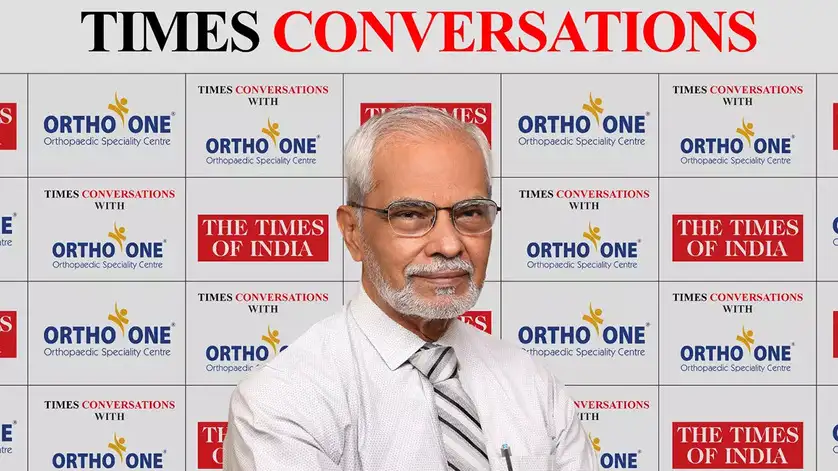“Active rest one of the key factors in the recovery of about 90 per cent of sports-related injuries. It means keeping the uninjured parts as active as possible,” said Dr David V Rajan, chairman and managing director of Ortho-One Orthopaedic Speciality Centre in Coimbatore. Discussing the scope of arthroscopy in sports medicine at The Times of India’s Times Conversations, he said icing, rest, and rehabilitation are areas where physical therapists play a vital role in treating sports injuries.Support for athletes“In several foreign countries, a sports team will have a physician trainer who understands the game and also takes on the role of physical therapist and psychologist,” he said, adding that Indian teams still lack such professional support.He emphasised that early treatment is the best treatment. “If an athlete is injured, they should not return to the arena without proper treatment, including rehabilitation, diet and adequate active rest. Only after full recovery should they resume full physical activity,” he noted underlining that rest should be accompanied by positive mental imagery for effective and swift recovery.Sports injuriesSports injuries typically fall into two main types—acute and chronic. Acute injuries occur suddenly, often due to a fall, a direct impact, or an awkward twist of a joint. Think sprains, fractures or dislocations are often results of inadequate warm-up and agility.Chronic injuries, on the other hand, build up over time. They’re usually caused by repetitive stress on a particular part of the body, like swinging a racket or running long distances. Common examples include tennis elbow and shoulder dyskinesis. Treatment for a sports injury depends on the type of injury often adequate stretching and correcting muscle imbalance will suffice.
What triggers a sports injury?An acute sports injury usually happens when a sudden force or impact overwhelms what a joint, muscle, or bone can handle. In contrast, chronic injuries are more slow-burning; they’re often the result of repeating the same movement over and over again, placing ongoing stress on the body without adequate preparation. Interestingly, overuse injuries can wear down tissues and joints over time, leaving them more vulnerable to sudden, acute damage.Medical aid at sports eventsHighlighting the importance of a medical team, he said a law may soon mandate the presence of ambulances, doctors, physiotherapists, and other professionals at high-level sporting events. “Only then can athletes be treated in time and return to the game quickly,” he added.Insisting on quality treatment along with quality infrastructure, Dr Rajan said playgrounds are often sub-standard, especially at the school level. Jumping pits, for instance, may not be adequately filled with mud, leading to serious leg injuries.“Only one per cent of sport-related injuries require surgery,” he added.Science behind sports medicine“There’s a lot of science behind sports medicine,” said Dr Rajan. “We now have equipment that can identify which muscles are not functioning properly. This allows athletes to focus on strengthening those areas. The same equipment helps detect muscular imbalances, aiding in balance training.”The sports medical team, he said, comprises a non-surgical doctor who accompanies the team, attending even to minor ailments like headaches. The doctor also ensures compliance with WADA (World Anti-Doping Agency) guidelines and plays a role in strength assessment and balance training.A typical sports medicine team also includes a nutritionist to monitor diet, a sports scientist, an orthopaedic surgeon, and a physical medicine expert.Surgery and mental healthSurgery, he reiterated, is required in only one to two per cent of cases. The real focus should be on strength training, proper stretching, conditioning, effective nutrition, appropriate clothing, and mental resilience.“One cannot win all the time—there will be losses,” he said, stressing the role of sports psychologists. “These setbacks can be stressful. A psychologist helps boost morale and ensures athletes return with a positive mindset.”Roles in sports medicine“Anyone can be a sports medicine specialist,” he said, citing the example of Cuban teams that engage dentists due to frequent jaw and tooth injuries. “In fact, parents often play a key role. They know their children best and can help doctors identify concerns. Many athletes visit with their parents these days.”Continuance of injured sports athletes will not only result in decrease in performance but also return after chronic injury may result in the athlete losing bright career.Scope and focus“We treat all kinds of athletes from kabaddi, football, and cricket to sprinters and throwers,” he said.He added that most injuries are preventable. “Young athletes often injure themselves at the peak of their career due to lack of strength and conditioning. Along with adequate rest, players must consistently engage in strength and endurance training, proper warm-up, and stretching.”Injuries and causesOrtho-One Orthopaedic Speciality Centre’s Dr Rajan said knee, shoulder, and tibia injuries are most common. Stress fractures are often caused by hard training surfaces or poor technique. “These can be prevented with better training and infrastructure,” he noted.Coaches, he said, must be well informed about recent advances and ensure players are not overexerted and that they receive sufficient rest. For example, shoulder injuries and pain are very common among overhead athletes. This is because the muscle in the front of the shoulder becomes stretched and strong and muscles behind the shoulder get tight and cause over use injury. This can be easily prevented by the coach and the trainer by adequate stretching, balancing and strengthening.When to intervene“At most hospitals, sports injuries are treated promptly. Doctors conduct MRI and X-rays in case of suspected serious injuries. If reports show no abnormalities, the condition can be managed with icing and rest. In nine out of ten cases, active rest is sufficient. Only one case may involve a ligament tear or a serious injury may need intervention,” he concluded.Role of sports managers and coachesWith continuous advancements in sports science and medicine, it is essential for sports managers and coaches to stay updated. Their knowledge directly impacts team performance and the longevity of an athlete’s career. Timely medical intervention should never be delayed—early diagnosis, proper treatment, or surgery (if required) can ensure the athlete recovers fully and returns to their peak performance level.Disclaimer: The views and opinions expressed in the story are independent professional judgment of the experts and we do not take any responsibility for the accuracy of their views. This should not be considered as a substitute for medical advice. Please consult your treating physician for more details. TIL is not liable for the correctness, reliability of the content and/or compliance of applicable laws. The above is non-editorial content and TIL does not guarantee, vouch or endorse any of it. Please take all steps necessary to ascertain that any information and content provided is correct, updated, and verified.”








